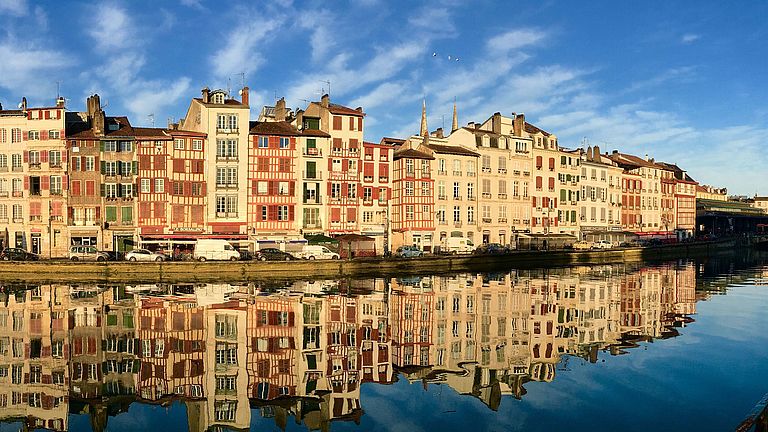Bayonne: both plural and singular
Bayonne : a fortified city
As a hub for travellers passing through as well as for deeply rooted inhabitants, Bayonne is not only the port of entry to the Basque Country – it is also a harbour city that is resolutely open to the world. It’s a great stopping point with a down-to-earth centrality that the official Latin motto, numquam polluta (“never soiled”), really drives home. Impressively, the fortified city has held up against fifteen sieges. The Château-Neuf, designed for military surveillance of the entire city and surrounding area, was built after Bayonne was taken back by the King of France in the mid-fifteenth century.
Bayonne : a capital city
Its central role positions Bayonne as the administrative, cultural, and economic capital of the Basque Country, just as it once was the political capital of Labourd, one thousand years ago. It is also a renowned commercial hub with a strong, diversified identity as a city of merchants. This attractive, expansive determinism has undoubtedly made it the prime spot that it is for welcoming outsiders. The population of Bayonne, currently 50,000, is continuing to grow.
The city has experienced bouts of rapid growth in the past as well, such as when the Jewish peoples of the Iberian Peninsula, fleeing the Spanish Inquisition, brought the delicious secrets of chocolate to the city’s kitchens 500 years ago. More recently, Basque refugees developed the popularity of poteo as the art of social life in the bars of Petit-Bayonne.
The Bayonne lifestyle
Spain also thrusts a horn in, haunting France’s oldest bullfighting spot in the Bayonne Arena, and lending its tapas to micro-gastronomy on the cool banks of the Nive. The lifestyle here is a convergence of all the identities of Bayonne, embodied in the heart of a city with three neighbourhoods, each with their own distinct character: Grand-Bayonne, Petit-Bayonne, and Saint-Esprit.
Celebrating in style
Bayonne is the sum of its neighbourhoods, which need no walls to set them apart from one another, their contours having been planned out by Vauban. The city’s take on living carries over to its festivities as well. When it comes to celebrating music and the local ham, Bayonne asserts its role by actively sharing the city’s traditional festivals in summertime, turning them into one of France’s most visited popular events. In the same joyous spirit, the Aviron Bayonnais rugby fans have earned a prestigious spot in the Top 14 spectator groups.
Bayonne has a special blend of colours, art and history, character and passion. It is a masterpiece that recalls the remarkable works housed in the Bonnat-Helleu fine arts museum, boasting a collection that is unparalleled between Paris and Madrid. Bayonne is an epicentre of nuances, engraved in stone, that shapes a personality that is unequivocally plural and yet so singular.

